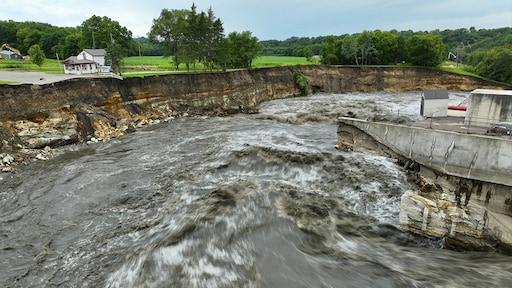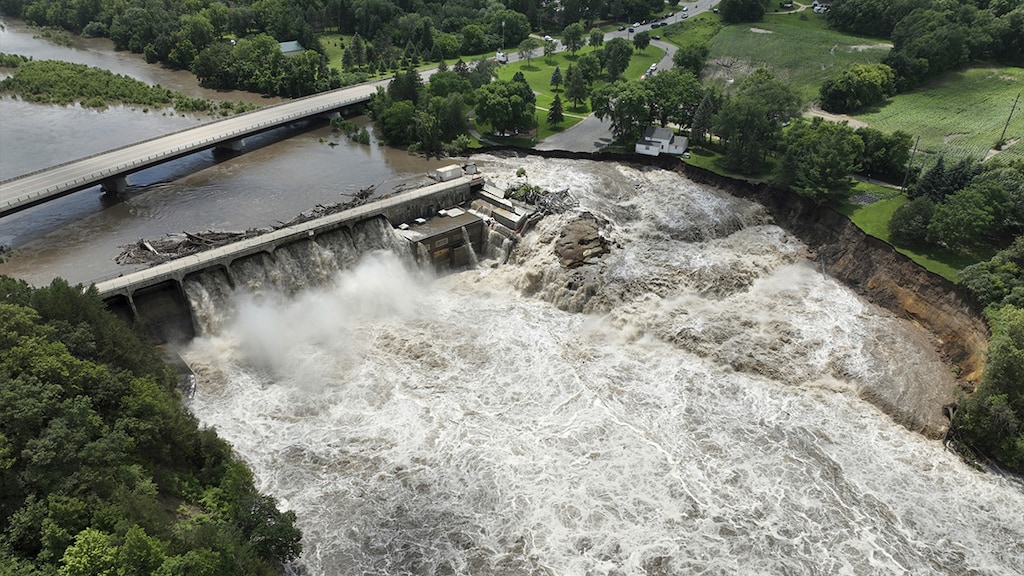By RTL News·10 minutes ago·Modified: 2 minutes ago

from right to left
Something went wrong with a dam in Minnesota last week. It partially breached, dragging a house away. It’s drawing attention to a problem that’s been known for years: Thousands of dams in America are in such poor condition that they risk collapse.
“There are more than 90,000 dams in the United States, and 2,500 of them are in the risk category,” says Edgar Westerhoff, a Dutch hydraulic engineer who has lived in New York for 12 years. He is the U.S. climate adaptation manager for a consulting and engineering firm. Arcadis.
“This does not necessarily mean they are on the verge of collapse, but it does mean that the impact could be significant. In very extreme situations, human lives are at risk and the economic damage is significant,” he added.
Minnesota
The debate over dam safety in America has reignited after the Rapidan Dam disaster in Minnesota. The dam was built in 1910. After the floods of 2019 and 2020, an energy company stopped leasing it. During an inspection last May, the dam was approved for construction, despite the discovery of significant damage to the concrete.

Last week, part of the Rapidan Dam failed. It happened after three days of heavy rains, which caused the river to rise exceptionally high. A neighboring house was swept away. Owner David Hruska had just enough time to remove the most important items from his home. He never expected something like this: “It’s ridiculous what the water can do. I never expected our house to disappear like this in a million years.”
Old Topics
Many of the dams are old, with one in Minnesota being 114 years old. Dams are built to last 50 years. But the average age of all dams in America is 57 years. “The quality is generally not good,” Westerhoff said. “A lot of the infrastructure is outdated and out of service. That’s a problem during heavy rains.”
Extreme precipitation is a growing problem due to climate change. “The outlook is not good this year, the ocean temperature is very high, there are more hurricanes, there is more heavy rainfall,” says Westerhoff. “So you also have to see if the criteria still meet the current extreme climate conditions.”
Never before has a hurricane as powerful as Beryl been so early in a hurricane season. That's no coincidence; in fact, Beryl may be a harbinger of a violent hurricane season. We explain how that works in the video below.
Repair costs
According to the Association of State Dam Safety Officials, which advocates for dam safety, it would cost $150 billion to make all the dams safe again, but President Biden has allocated just $3 billion in his $1 trillion infrastructure master plan.
“Because the overdue maintenance of other infrastructure also costs a lot of money,” says reporter Eric Mothan. “Roads, bridges, railways, internet, water and electricity supplies all need to be renovated too.”
Hence, according to Muthan, bad dams are not a top priority. “Americans accept late maintenance because they pay less in taxes. Americans are good at helping when there is a disaster, but they don’t want to give money to prevent a potential disaster.”
New York
But according to hydraulic engineer Edgar Westerhoff from Arcadis, not all dams need immediate action. “There is never enough money to put the entire infrastructure in order. It is about the dams that are most at risk and most impactful if they collapse. These are known. We are working to fix them.”
And the big cities are well protected, says Westerhoff, New York for example: “New York’s water supply comes from the Catskill Mountains, a forested area in northern New York, with large reservoirs. The dams there are constantly monitored and adhere to the highest safety requirements.”
How many times did it go wrong?
Between 2013 and 2023, there were problems at 283 dams. These ranged from minor incidents to events with serious consequences. In 2017, 190,000 people had to be evacuated in California after heavy rains damaged the Oroville Dam. In 2019, a snowstorm in Nebraska caused a dam to fail, sweeping away a home. The resident did not survive.
Source: State Dam Safety Officials Association

Zombie specialist. Friendly twitter guru. Internet buff. Organizer. Coffee trailblazer. Lifelong problem solver. Certified travel enthusiast. Alcohol geek.
